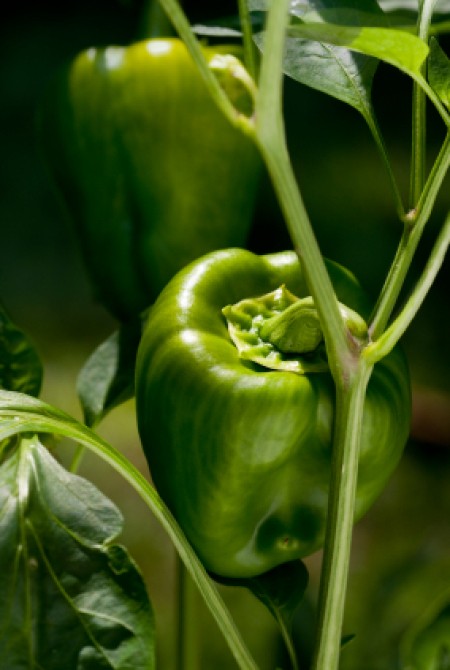If you've never made room in your garden for bell peppers, consider giving them a try. They're easy to grow, nearly pest and disease-free, and they produce a lot of yield in a small amount of space. You can either buy transplants locally, or start seeds yourself. Here are the basics of what you need to know to get started.
Bell peppers belong to the Solanaceae, or nightshade family of vegetables. Relatives include potatoes, eggplants, and tomatoes. They are native to Central and South America, and depending on the variety, come in red, green, orange, yellow, and black. Red bell peppers are actually green peppers that have been allowed to color up on the vine.
When planting bell peppers, plan on 3 to 4 plants per person. Depending on the variety, peppers will reach maturity approximately 65 to 80 days from transplanting.
Sow seeds indoors: In most parts of the country, the growing season is too short to start seeds outdoors. Instead, sow seed indoors 7 to 8 weeks before the last spring frost. Plant 1/4 inch deep in a moist, soil-less mix and keep seeds warm (70 degrees F) until they germinate - in approximately 10 to 15 days. Move sprouts into full sunlight as soon as the first shoots appear. Seedlings can be moved to individual pots in 2 to 3 weeks, or as soon as the plants are large enough.
Transplanting: Bell peppers grow best at temperatures between 65 and 80 degrees F, so don't transplant seedlings until at least two weeks after the last spring frost. At temperatures above 80 or below 60 degrees, blossoms may drop without setting fruit. Avoid planting peppers where potatoes, eggplants, or tomatoes have been grown in the past 5 years, as all members of the nightshade family are prone to the same diseases.
Location: Full sun; well-drained soil.
Watering: Peppers will tolerate some drought, but perform best when they receive consistent moisture around their roots. Avoid watering plants from overhead - especially when they are blooming, as the water can wash away pollen and wet leaves encourages fungal and wilt infections.
Fertilizer: In well amended soil, peppers generally don't need any supplemental fertilizer. Pale leaves, however, may indicate that plants are suffering from a nutritional deficiency. In this case, spray weekly with a mixture of kelp and fish emulsion until they bloom.
Maintenance: Apply mulch to suppress weed growth, maintain even soil temperatures, and prevent soil-borne diseases from splashing up on fruits. Plants may need staking or caging as they grow to prevent stems from bending over and fruit from touching the ground. Peppers are not prone to diseases to speak of, but watch for wilt and fungus, and keep an eye out for cutworms and flea beetles.
The stems and branches of pepper plants are brittle and break easily - especially when bearing heavy fruit; so work carefully when harvesting. Cut the fruit from the bush using a small, sharp knife. Leaving about 1 inch of stem intact on each pepper will give them a longer storage life. Harvesting can take place at almost any stage of development.
If you want green peppers, pick them as soon as they are big enough for use. Leaving a few peppers on the plant may slow down production, but the peppers will taste much sweeter (and are more nutritious) if allowed to turn red on the vine. If your growing season is short, harvest your peppers as late as possible and keep them in a cool place to color up (check them often for rotting).
Use bell peppers raw or cooked. Cut them into strips, cubes, to thin slices and use them in salads or casseroles. Whole peppers stuffed with a meat, rice, or vegetables mixture also make a great summer entree. One of the most nutrient-dense foods in the garden, bell peppers contain high amounts of vitamin A and C, with the red peppers being higher in nutrients than the green.

About The Author: Ellen Brown is an environmental writer and photographer and the owner of Sustainable Media, an environmental media company that specializes in helping businesses and organizations promote eco-friendly products and services.
Add your voice! Click below to comment. ThriftyFun is powered by your wisdom!
Very good article, Ellen. I think failure with these peppers is often due to their requiring a long growing season not being considered.
I have read that they are perennial in southern states. So a reader recommended digging up at the end of the year. Pruning some and out again once frost is over.
Add your voice! Click below to comment. ThriftyFun is powered by your wisdom!